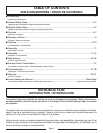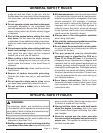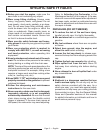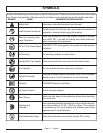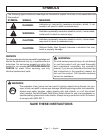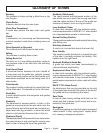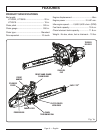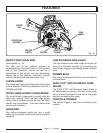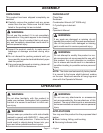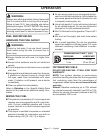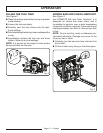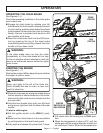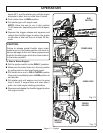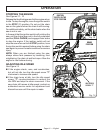
Page 3 — English
WARNING:
Read and understand all instructions. Failure
to follow all instructions listed below, may result
in electric shock, fire and/or serious personal
injury.
READ ALL INSTRUCTIONS
Know your tool. Read the operator’s manual
carefully. Learn the saw’s applications and
limitations as well as the specific potential
hazards related to this tool.
Kickback may occur when the nose or tip of
the guide bar touches an object, or when the
wood closes in and pinches the saw chain in
the cut. Tip contact in some cases may cause a
lightning-fast reverse reaction, kicking the guide
bar up and back toward the operator. Pinching
the saw chain along the top of the guide bar
may push the guide bar rapidly back toward the
operator. Either of these reactions may cause
you to lose control of the saw, which could result
in serious personal injury. Do not rely exclusively
upon the safety devices built into the saw. As a
chain saw user, you should take several steps
to keep your cutting jobs free from accident or
injury.
• With a basic understanding of kickback,
you can reduce or eliminate the element
of surprise. Sudden surprise contributes to
accidents.
• Keepagoodfirmgriponthesawwithboth
hands when the engine is running. Place
your right hand on the rear handle and
your left hand on the front handle with your
thumbs and fingers encircling the chain saw
handles. A firm grip together with a stiff left
arm will help you maintain control of the saw
if kickback occurs.
• Make sure that the areain whichyou are
cutting is free from obstructions. DO NOT
let the nose of the guide bar contact a log,
branch, fence, or any other obstruction that
could be hit while you are operating the
saw.
• Cut at high engine speeds. Always cut
with the engine running at full speed. Fully
squeeze the throttle trigger and maintain a
steady cutting speed.
• Donotoverreachorcutabovechestheight.
• Follow the manufacturer’ssharpening and
maintenance instructions for the saw chain.
• Only use replacement bars and chains
specified by the manufacturer or the
equivalent.
Do not operate a chain saw with one
hand. Serious injury to the operator, helpers,
bystanders, or any combination of these
persons may result from one-handed operation.
A chain saw is intended for two-handed use.
Do not operate a chain saw when you are
fatigued. Fatigue causes carelessness. Be more
cautious before rest periods and towards the
end of your shift. Never operate a chain saw
when you are tired or under the influence of
medication, drugs, or alcohol.
Use safety footwear. Wear snug-fitting
clothing, protective gloves, and eye, hearing,
and head protection devices.
Heavy protective clothing may increase
operator fatigue, which could lead to
heat stroke. During weather that is hot and
humid, heavy work should be scheduled for
early morning or late afternoon hours when
temperatures are cooler.
Do not stand on any unstable surface while
using the chain saw, that includes ladders,
scaffolds, trees, etc.
Use caution when handling fuel. Move the
chain saw at least 30 feet from the fueling point
before starting the engine.
Do not allow other persons to be near the
chain saw when starting or cutting with the
chain saw.Keepbystandersandanimalsout
of the work area.
Do not start cutting until you have a clear
work area, secure footing, and a planned
retreat path from the falling tree.
Keep all parts of your body away from the
saw chain when the engine is running.
Always carry the chain saw with the engine
stopped and the chain brake engaged, the
GENERAL SAFETY RULES




